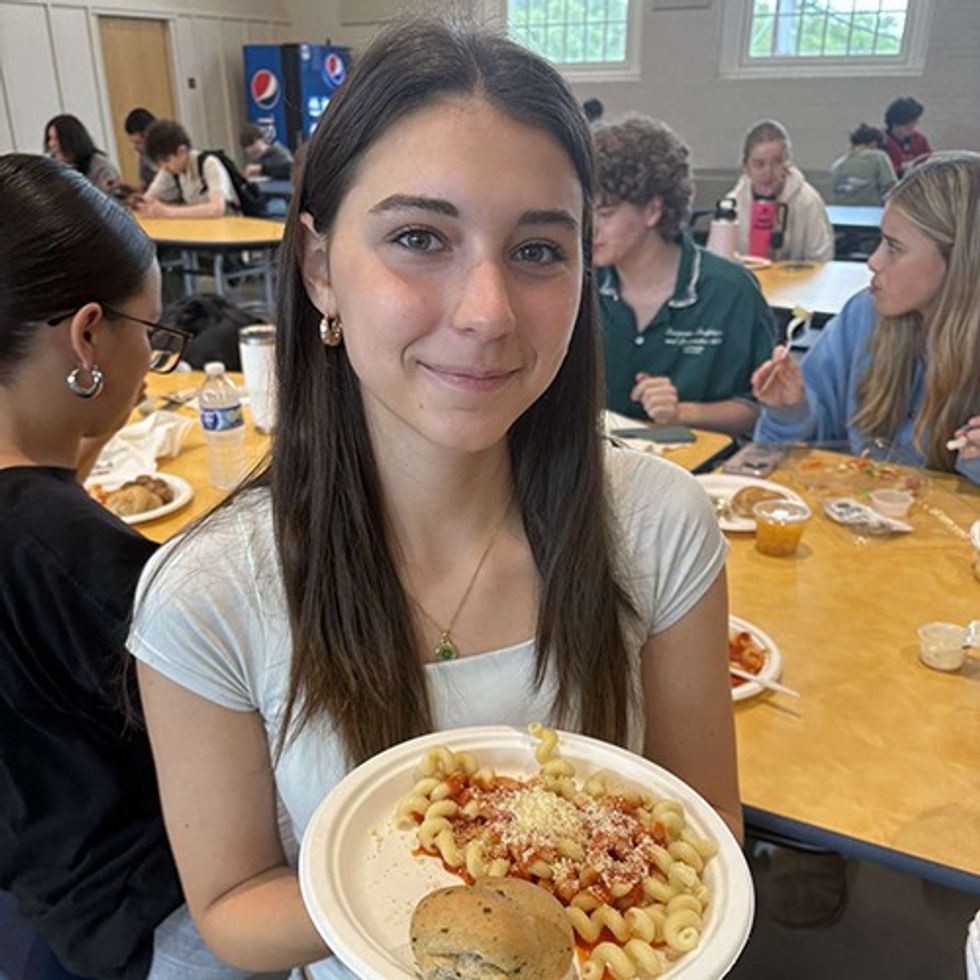Latest News
Charlie Castellanos, left, and Allegra Ferri, right, sitting in the HVRHS library to talk about their experiences in the U.S.
Anna Gillette
“I would say if you are thinking about doing the program, do it because you get out of your comfort zone and learn so many things...” —Charlie Castellanos
Every year, Housatonic Valley Regional High School welcomes foreign exchange students to attend classes through the AFS Intercultural Programs. This school year, two students traveled to Northwest Connecticut to immerse themselves in American life and culture. Allegra Ferri, a 17-year-old from Italy, and 16-year-old Charlie Castellanos from Colombia sat down to reflect on their experience at HVRHS. As the academic year is coming to an end, they shared a few highlights of their time in the U.S. and offered advice to prospective exchange students.
What has been your favorite part of your exchange experience?
Allegra: “My favorite part of this exchange year was coming here and experiencing an American high school.”
Charlie: “My favorite part is coming to high school and living the American dream and probably going to ski [for the first time].”
What extracurricular activities have you been involved with?
Allegra: “I played volleyball in the fall and I really liked it because everyone was so nice. Then during the winter, I was part of the crew for the musical and now I’m doing tennis. I really enjoy it because it’s a good team. I love how American high school has sports and activities after school.”
Charlie: “I did soccer in the fall, which was my favorite. I did the play in the winter and right now I’m doing track and field. We don’t have school sports in Colombia. This is one of the things I’m going to miss the most.”
What would you say to someone considering doing an exchange year?
Allegra: “I would say do it because living in another country is a great experience to grow and improve another language. It improves your skills of being by yourself.”
Charlie: “I would say if you are thinking about doing the program, do it because you get out of your comfort zone and learn so many things like culture, language and it’s just a completely new experience. It will stay with you your entire life.”
Keep ReadingShow less
From left, Ibby Sadeh, Anna Gillette, Nathan Miller, Maddy Johnson and Caitlin Hanlon proof the pages of HVRHS Today at the Lakeville Journal office while Shanaya Duprey teleconferences in on Thursday, May 29.
James H. Clark
Students from Housatonic Valley Regional High School wrote and produced the inaugural edition of HVRHS Today, a new publication by and for students in the Northwest Corner.
This inaugural issue of HVRHS Today marks the first student-led journalism effort at the high school in several years. The program is a collaboration between the Lakeville Journal, the Berkshire Taconic Community Foundation and the 21st Century Fund.
Anna Gillette, Mia DiRocco, Shanaya Duprey, Madelyn Johnson and Ibby Sadeh volunteered to form the first group of students comprising the staff of the HVRHS Today.
The five girls got to work just before spring break, meeting as a group of reporters for the first time at the Lakeville Journal office in Falls Village on Wednesday, April 9. That night, the team hit the ground running throwing out ideas for their first reporting projects and discussing the basics of gathering news and reporting facts.
In the following weeks, the students gathered weekly every Thursday at the Lakeville Journal office to discuss interviewing, writing and reporting and plan their coverage for the paper. The students took the lead at every turn, choosing which topics they would like to cover and deciding what sources were best for each story.
Anna Gillette, of Lakeville, joined the program out of a passion for research writing and a desire to learn about a potential career path. “I don’t really know what I want to do in the future and I don’t know what career I want to pursue,” Gillette said. “So I think that this is a good opportunity to, kind of, test the waters to see if this is something I would be interested in.”
Gillette contributed reporting on the latest production of the high school’s Unwritten Show, a completely student-led annual production written this year by Sara Huber and co-directed by Huber and Alex Wilbur. Gillette also reported on and profiled the winner of this year’s “Next Top Mountaineer” pageant, a senior named Manny Matsudaira.
Madelyn Johnson, of North Canaan, said she joined the program to hone her writing skills. “My English teacher calls me a ‘stupendously boring writer,’” Johnson said. “There’s not much emotion or anything in my writing. It’s pretty much just fact, fact, fact.” This is a good thing, Johnson said, for Advanced Placement tests, but not necessarily for more creative assignments.
The program pushed Madelyn Johnson out of her comfort zone, something she said her mother has spent her whole life teaching her to appreciate. “My mom has always had me facing my fears,” Johnson said. “Even if I didn’t always like them, I was always sort of forced to try new things. So I’m trying to continue that with the new independence I get as I grow up.”
Johnson profiled the seniors of the HVRHS track team that will be going on to run for their collegiate teams after graduation, and Richie Crane, who won a Sondheim Award for his performance of Old Man Strong in this year’s production of “Urinetown.”
Mia DiRocco, of Cornwall, said she wants to pursue a career in journalism after graduation. “I’m really passionate about politics, and now is a great time for that,” DiRocco said. “And I’m really interested in international relations, linguistics — and I love writing — so, it’s a career that I think encompasses all my interests in one.”
DiRocco focused her reporting on the no-longer-imperiled tennis team and sports involvement at HVRHS in general. Her reporting dug into the benefits of the brand new tennis courts and the efforts required to bring back previously dissolved groups — like the recently reformed cheerleading team.
Ibby Sadeh, of Falls Village, said she expected the program to help her with her social skills. “From the first meeting I definitely thought it could be fun and valuable to learn new skills and build on my social skills,” Sadeh said. “And also help with my writing skills. I’ve only done essays and reflections for class. I haven’t actually written in this form before.”
Sadeh contributed the inaugural reporter’s notebook report, reflecting on this year’s trip to Europe. Sadeh also worked with DiRocco to recap the first year behind the scenes with the Bias Education and Response Team, and with Gillette to produce a Q&A with this year’s foreign exchange students — 17-year-old Allegra Ferri from Italy and 16-year-old Charlie Castellanos from Colombia.
Shanaya Duprey, of North Canaan, like many of her compatriots in the program, wanted to seize an opportunity to improve her writing, but for a career in marine biology. “I’ve always been really interested in animals,” Duprey said. “I’ve found a new passion for the ocean. There’s not a lot of attention on marine conservation so I’d like to do that.” Duprey said style of researched, journalistic work she produced for HVRHS Today could help her in a future career as a scientist writing and submitting grant proposals and research papers.
Duprey focused her reporting over the past six weeks on the 21st Century Fund, a nonprofit organization that provides funding for educational opportunities and scholarships to HVRHS students. Her reporting focused on Silas Tripp, a student at HVRHS that could attend multiple educational engineering camps thanks to money from the 21st Century Fund.
HVRHS Today can be found online at www.lakevillejournal.com/hvrhs-today.
Keep ReadingShow less
Mountaineers take second place in WCLC
May 30, 2025
WATERTOWN — Housatonic Valley Regional High School girls lacrosse played Watertown High School for the Western Connecticut Lacrosse Conference championship Wednesday, May 28.
The cold, rainy game went back and forth with three ties and three lead changes. Watertown was ahead when it counted and earned a 6-4 victory to claim the league title.
Under the lights in Watertown, both sides displayed defensive discipline in a hard-fought match. It was the third meeting between these two teams this season and Watertown completed the sweep in the title game.
Watertown scored first in the opening minute. Housatonic quickly evened the score when freshman Annabelle Carden tucked a shot past the goalie on a fast break. The first quarter ended 1-1.

HVRHS pulled ahead with another goal from Carden in the second quarter. A few minutes before half time, Watertown tied it up again at 2-2 going into intermission.
Watertown regained the lead in the second half before HVRHS answered with a goal by senior Tessa Dekker. With seconds left in the third quarter, the Warriors went up 4-3.
As the sky darkened and rain intensified in the fourth quarter, Watertown built a lead. They scored twice in a row to start the final period and entered clock-management mode to drain time. Senior Lola Clayton scored once more before time was out and the game ended 6-4.

The championship’s most valuable player award went to Malia Arline of Watertown. HVRHS had five players chosen to the 2025 all-league team: Lola Clayton, Lou Haemmerle, Mollie Ford, Neve Kline and Georgie Clayton.
“Incredible finals. Incredible game to watch,” said HVRHS Coach Laura Bushey to her team post-game. “You should all be very proud of yourselves.”
“Holding a team to six points is something to be really, really proud of. Especially a team that’s as good as these guys,” said assistant coach Erin Bushey.
HVRHS qualified for the Connecticut Interscholastic Athletic Conference Class S lacrosse tournament. The Mountaineers got matched against Wolcott High School in round one May 30. HVRHS won 13-6 and advanced to the second round to play top ranked Lauralton Hall June 3 in Milford.

Keep ReadingShow less
John DeDonato
Class of 2027
“Some I prefer are the grilled cheese. Pizza’s okay with some sauce. Hamburger too, I guess. The least favorite that I’ve tried is probably the hot ham and cheese. I don’t like that. I’ve started to see that they’re doing French fries, which I kind of like. They should probably start doing more of that.”
Abram Kirshner
Class of 2026
“My favorite lunch is probably the mac and cheese and popcorn chicken. I’d like to see it more frequently. Grilled cheese, cheese quesadilla, french toasts sticks, and chicken fajita
can all go.”
Georgie Clayton
Class of 2027
“My favorite is beef nacho grande. My least favorite is probably the fajitas.
I wish we had chicken nuggets and mashed potatoes more often.”
Celeste Trabucco
Class of 2026
“General Tsou’s chicken is my favorite lunch. Also, the popcorn chicken and mac and cheese.
I really don’t like the French toast sticks or that we have pizza every Friday. We need some more variation.”
Photos by Ibby Sadeh and Mia DiRocco
Keep ReadingShow less
loading













